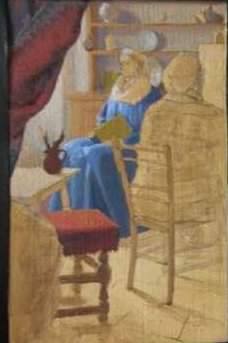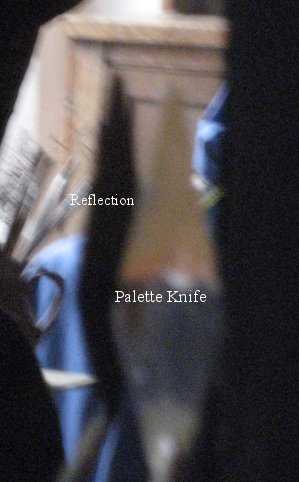After some days of very poor light Anne has very nearly completed the painting. Using the size of the image as seen in the easel mirror the painting is remarkably small. Although the necessary space for a studio using the mirror method is very small the visual distance from the main subject (Rembrandt and side-board) is actually 3.95 m, this is because the light hits the large mirror then the second mirror on the easel and finally comes to her eye. This distance causes the small image.

Anne's Painting
Our big mirror was narrower than Vermeer’s, accounting for our somewhat cramped composition. By using a wider mirror than we have behind, the angle of vision could be widened considerably.
The large areas of fabric or carpet that one finds in the foreground in many of Vermeer’s paintings was there to provide an undemanding area of the painting that would cover over the area where he would have seen himself directly reflected in the easel mirror. In Anne’s case we see her right shoulder blotted out the left-hand corner of the picture which she then painted with green and striped fabric following Vermeer’s example. This is another strong argument in favour of Vermeer’s use of two mirrors rather that the camera obscura. With the camera obscura the artist is hidden behind the lens, so the image of the subject would have been complete.
I feel that Anne’s painting is very Vermeer like; in the simplifications of Rembrandt’s face for instance. Also in the very accurate and simple recording of the patches of light coming from the objects on the shelves behind, which gives precedence to the light rather than the description of the object itself. This is particularly typical and very much the result of the method of observation. Until someone comes up with something more Vermeer-like observed in a camera obscura; I am persuaded that this method, which was strongly hinted at in “The Art of Painting”, was in fact Vermeer’s method.
For me Vermeer is the first painter to be primarily concerned with light. It can be no coincidence that the inventor of the microscope lived in Delft. He was Vermeer’s contemporary, he was the first to see microbes swimming in water. The telescope also was a recent invention and was being improved throughout Vermeer’s life-time, bringing revolutionary knowledge to mankind through the medium of light. Light is the prime way we receive the outside world and Vermeer investigated its properties (focused and unfocused) with single minded “scientific”devotion. It was for this reason that he was obliged to use the camera obscura: to study unfocused light. He could have used it also for the planing stage of his paintings but two mirrors, or the better known methods mentioned above, would also have produced the same perspective effects.
|
The photo shows a reflection in the easel mirror (above) for comparison with the same in pewter (below). The pewter is a poor substitute for a 17thC silver-backed mirror which we believe Vermeer would have used but we do not possess. The pewter gives a tonal range that is too reduced to be of practical assistance to a painter. Silver turns black over a period of years in light. Experiment could show whether Vermeer's mirrors were new or old, certainly they would have been silvered. |
 The palette-knife is held against the reflection in the easel mirror to aid the process of matching the colours and tones. |